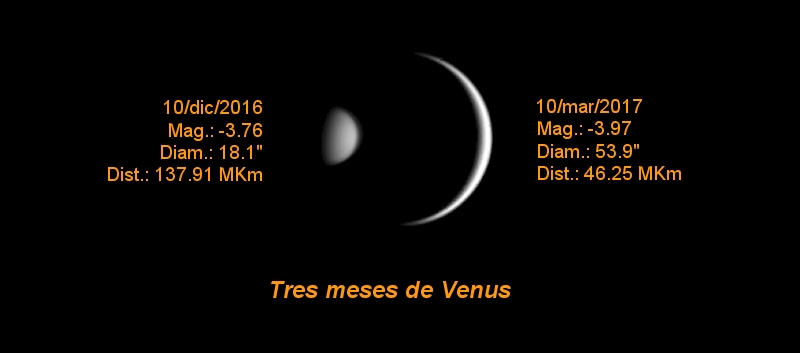
| |
| Tres meses de Venus
|
|
Venus
Venus size and phase comparition after three months |
|
| |
En español, más abajo.
In spanish, below.
As seen from Earth, both Mercury and Venus have phases like our moon. That's because they circle the sun inside Earth's orbit. Planets that orbit between Earth and the sun are known as inner or inferior planets.
The phases of Venus were first observed by Galileo Galilei in the early 1600s. He observed that the planet presented a complete series of phases very similar to those of the Moon, seeing at one point as a fully illuminated disk until it came to be seen like a thin sickle.
Inferior planets can never be at "opposition," which is when the planet and the sun are on opposite sides of Earth. But inferior planets can be at "conjunction," which is when a planet, the sun and Earth are all in a straight line. Conjunction can happen once when the planet is on the opposite side of the sun from Earth and again when it's on the same side of the sun as Earth. When a planet is on the opposite side of the sun from Earth, we say it is at "superior conjunction." As the planet moves out from behind the sun and gets closer to Earth, we see less and less of the lit side. We see phases, similar to our moon's phases.
Venus will pass very close to the Sun in the sky toward its own inferior conjunction on March 25 2017. Watch its crescent get thinner and thinner as the planet's size appears larger and larger, because it is getting closer to Earth.
This marks the end of Venus's apparition in the evening sky and its transition to become a morning object over the next few weeks. At closest approach, Venus will appear at a separation of only 8° from the Sun, making it totally unobservable for several weeks while it is lost in the Sun's glare.
Venus will also pass perigee – the time when it is closest to the Earth – at around the same time, since it will lie on exactly the same side of the Sun as the Earth in the Solar System. It will move to within a distance of 0.28 AU from the Earth, making it appear with its largest angular size. If it could be observed, it would measure 59.4 arcsec in diameter, whilst appearing completely unilluminated.

Desde la Tierra, Mercurio y Venus tienen fases como nuestra luna. Eso es porque circundan el sol dentro de la órbita de la Tierra. Los planetas que orbitan entre la Tierra y el Sol son conocidos como planetas interiores o inferiores.
Las fases de Venus fueron observadas por primera vez por Galileo Galilei a principios de 1600. Observó que el planeta presentaba una serie completa de fases muy semejantes a las de la Luna, viéndose en un momento como un disco completamente iluminado hasta que llegó a ser una hoz fina.
Los planetas inferiores nunca pueden estar en "oposición", que es cuando el planeta y el sol están en lados opuestos de la Tierra. Pero los planetas inferiores pueden estar en "conjunción", que es cuando un planeta, el Sol y la Tierra están en línea recta. La conjunción puede ocurrir una vez cuando el planeta está en el lado opuesto del sol de la Tierra y de nuevo cuando está en el mismo lado del sol que la Tierra. Cuando un planeta está en el lado opuesto del sol de la Tierra, decimos que está en "conjunción superior". A medida que el planeta sale de detrás del sol y se acerca a la Tierra, vemos cada vez menos el lado iluminado. Vemos fases parecidas a las fases de nuestra luna.
Venus pasará muy cerca del Sol en el cielo hacia su propia conjunción inferior el 25 de marzo de 2017. Se va haciendo cada vez más grande porque se está acercando a la Tierra, pero cada vez con más fase.
Esto marca el final de la aparición de Venus en el cielo nocturno y su transición para convertirse en un objeto matutino durante las próximas semanas. En el acercamiento más cercano, Venus aparecerá en una separación de solamente 8 ° del sol, haciéndolo totalmente inobservable por varias semanas mientras que se pierde en el fulgor del sol.
Venus también pasará el perigeo - el momento en que está más cercano a la Tierra - en aproximadamente el mismo momento, ya que se situará exactamente en el mismo lado del Sol que la Tierra en el Sistema Solar. Se moverá a una distancia de 0,28 UA de la Tierra, haciendo que aparezca con su mayor tamaño angular. Si se pudiera observar, mediría 59,4 arcsec de diámetro, mientras que aparecía completamente sin iluminar.
|
|
| |
| Technical details: |
|
Location: |
Valdemorillo - Spain |
Date: |
10/03/2017 (dd/mm/yyyy) |
Conditions: |
Good |
Temperature: |
ºC |
Humidity: |
|
|
|
Telescope: |
Clestron 9.25 f/10
|
Reducer/corrector: |
No reducer
|
Filter: |
Baader Neodimiun 1.25"
|
Mount: |
Orion Atlas EQG
|
Camera: |
DMK 21AU618
|
Exposure: |
4000 frames @ 60fps |
Guiding tube: |
No guiding
|
Guiding camera: |
No guide camera
|
Guiding software: |
No guide software
|
|
|
Procesing: |
Registax |
|
Notes: |
10/dic/2016 - 10/mar/2017 |
|
| |
|
|
|
|

